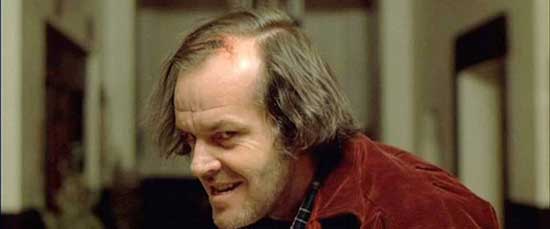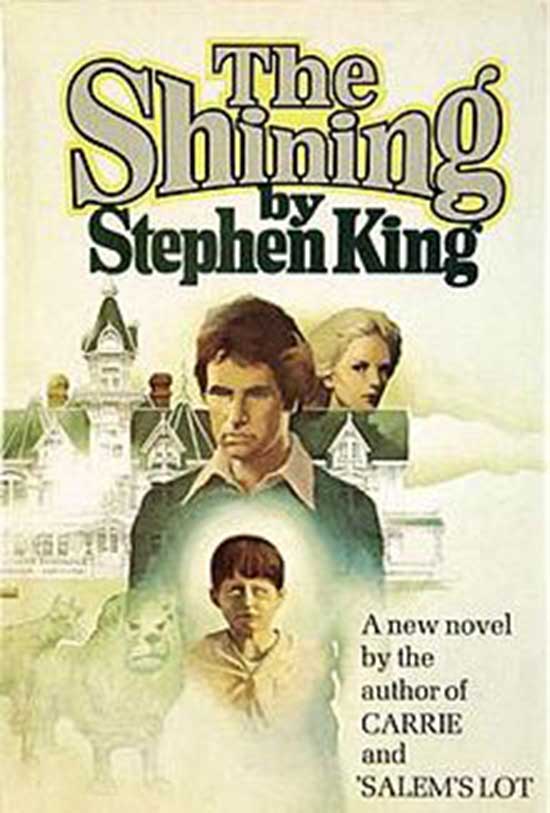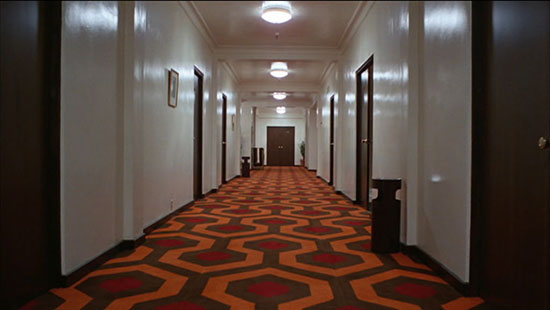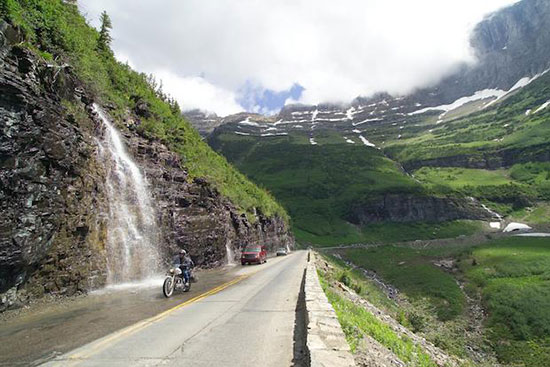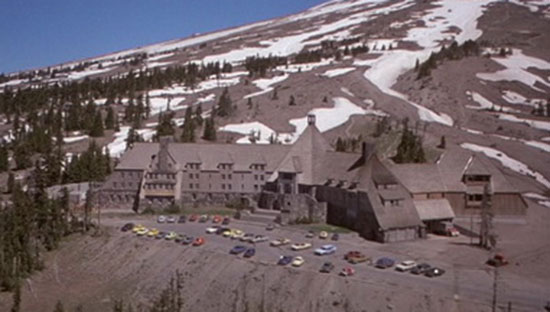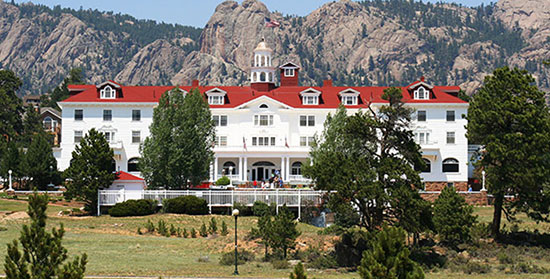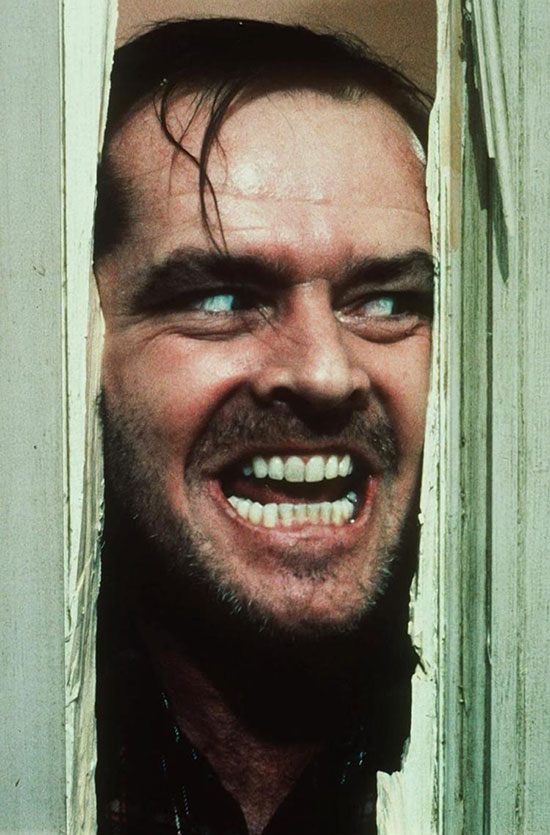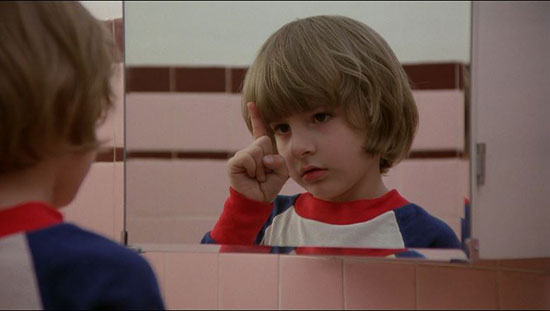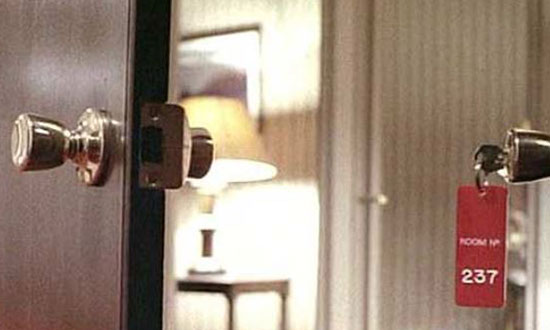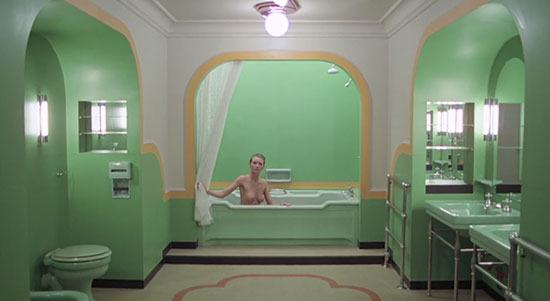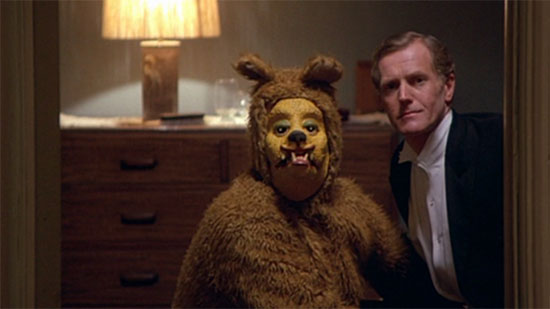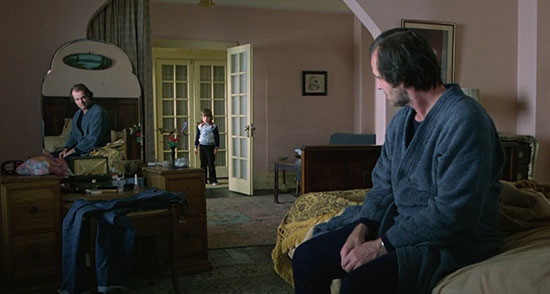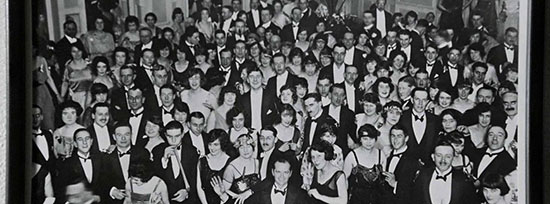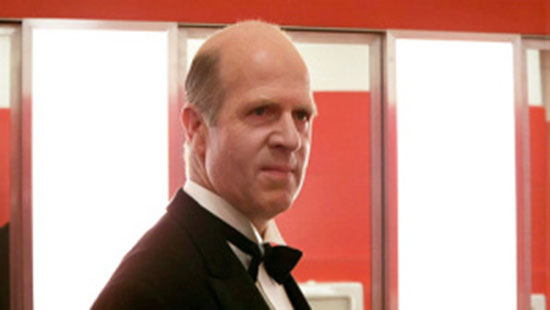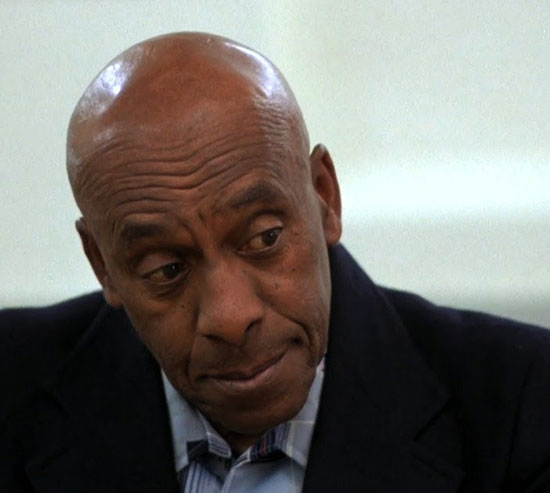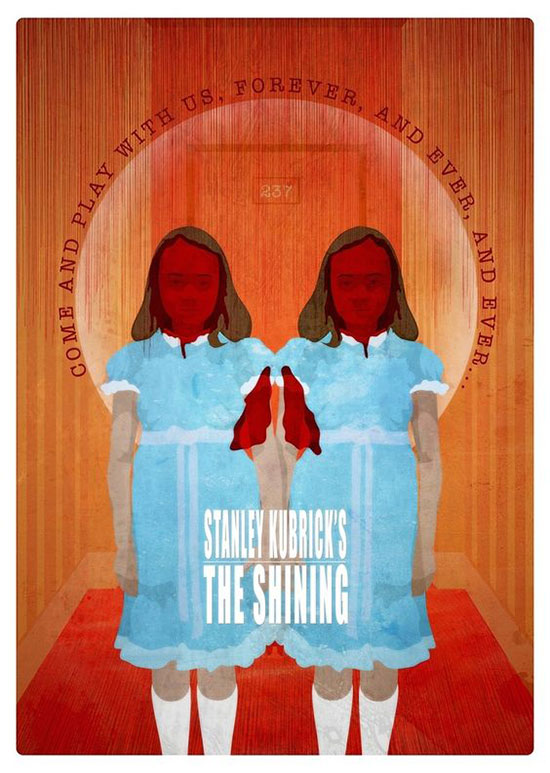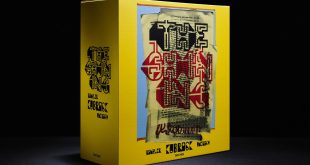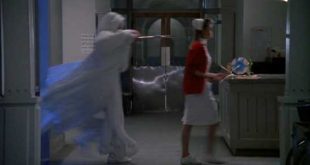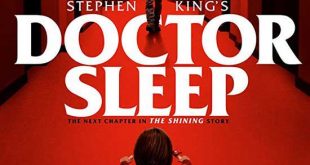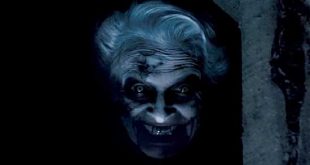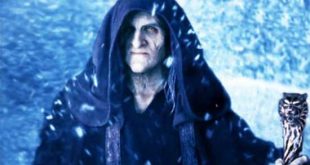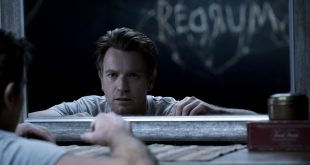First why The Shining, well, face it this movie contains so many theories and controversies, of which I researched and thought about the scope of the possible solutions, in addition, Stanley Kubrick’s direction always intriguing and mesmerizing, and yet sometimes quite maddening to both cast and crew. However, some find that tyrannical method a major downfall, although, a director is truly a dictatorship, he envisions a certain creation, a Renaissance Man, who enjoys wrapping puzzles insides riddles and placing them in pandora’s boxes scattering it all in vast array pf paintings and images on screen, while waiting discovery. One should realize this article contains many spoilers and reveals, so if you haven’t seen the movie or read the book, avoid this article, otherwise proceed and discover the world of dual realities and nightmares. Lastly, this Q and A reads more like a dissection of the film and the questions surrounding it.
What is the overall concept of the about?
Jack Torrance (Jack Nicholson), a recovering alcoholic along with his wife Wendy (Shelley Duvall) and son Danny (Danny Lloyd) takes a job as a winter caretaker at the isolated Overlook Hotel in the mountains of Colorado. As the winter months hit, locking the family in the confines of the hotel, isolationism and madness start, with Danny beginning to see ghosts and dealing with his gift (or curse) of The Shining, Wendy suffering mental breakdowns. Thanks to devilish ghosts using demon alcohol, lures Jack back to the booze and this comes from the hands of a previous caretaker, Delbert Grady (Philip Stone), who hacked his wife and two daughters into bits and the two discuss Jack needs to do a similar thing.
Is the Shining based solely on book?
Not exactly, this movie actually considers more of free adaption of the book, when Kubrick read the first version he found himself disgusted with it, and tossed most of it away, and created an atmospheric movie, rather than a straight ghost movie with layered psychic abilities, with the assistance of Diane Johnson. The actual book was published in 1977 by author Stephen King, that he, King found inspiration from John Lennon’s song “Instant Karma!” with the line ‘We all shine on’ and worked through his own demons, as a recovering alcoholic. In addition, King, dislikes Kubrick’s movie greatly and penned a three-part television series of The Shining in 1997 , in which Steven Weber stars as John Torrance and Mick Garris directed.
What are some the psychological methods that the average person might relate to?
For anyone, who’s ever spent the time indoors for a long time, especially during a blizzard, the mere peering outside, with the neighbors’ houses nearby, yet seems miles away due to perhaps not knowing them and the eerie quietness, just wind and snow damping all noise can become unnerving. Envision a storm lasting 20 hours carrying on for two days, crackling fire, and add to it the significance of it on a mountaintop, best to hope to engage work or many other activities. That isolationism works incredibly well in conveying a storyline to the average viewer, especially thanks to the opening sequence.
What makes the ‘opening sequence’ a true testament to storytelling countless years later?
Actually, a few things, first the road filmed in the beginning is an actual road, that many cinema and horror fans travel to experience the moment for the themselves, it’s called Going-to-the-Sun Road, running along the western shore of Saint Mary Lake in Glacier National Park, in northeast of Kalispell,, Montana. However, more the center point of the scene, taking note of the visuals, namely in daylight, and not darkness, the light showing openness and welcoming, while darkness death and gloom, add to the fact of the vehicles, not many travel upward, a few more descend down, showing the infrequent travelers, and that the nature becomes more dense and overcrowded, the higher shot showing isolationism, no one calls for help. Although, for a moment the peaceful does filter into the scene, shown by rising to the heavens. One needs note that Jack takes the drive by himself the first time for the initial interview, and shows the narrow road, tight confines, and the overwhelming danger. Simply not a place the weak mannered or minded individual, especially anyone battling personal demons.
Can one visit the hotel from the film?
Yes and no, first the actual hotel in the film was created on a sound stage in vast detail down to the product names using the correct locations on sample found containers, at the Elstree Studios in Hertfordshire, England. The exterior of the Overbrook Hotel presented as the Timberline Lodge, in Oregon, however the interior is based from Ahwahnee Hotel in Yosemite National Park, California, all rebuilt in England. Often The Stanley Hotel, in Estes Park, Colorado becomes confused with the movie, likely due the name and that the place where Stephen King wrote The Shining book in 1973 and 1974. In addition, the famed Gold Room (where the July 4th ball takes place) and red bathroom inspired by the Biltmore Hotel in Phoenix, Arizona designed by famed architect Frank Lloyd Wright (most recall his exterior design of Ennis House in “House on Haunted Hill (1959)”.
How much was acting and sheer directing when Nicholson chops through the bathroom door?
One, first must note that in rehearsals, some noticed how well Nicholson held the ax, which is a fireman’s axe, and then went through the door in one swing, at which a break occurred on set, and Kubrick realizing no way the scene could proceed that quick, but decided to compliment Jack on how well he handled the axe, (hence stroking his ego, while fishing, in other terms Stanley use chess maneuvers to hide his true intentions). Jack informed him nonchalantly that he was a volunteer fireman and learned how to take down a door fast. Hence with this information, Kubrick went to the set design personnel and ordered a special door, one with a reinforced thickness in the spot where Jack chops through the door. Therefore, it led to Jack, being called to set, and then Kubrick yelling cut, before the onslaught started, this repeated a few times, leading aggravation on Nicholson, finally when the tempered enrage the scene set the command “ACTION” and what the viewers see is Jack frustration boiling over as he can’t get through the door, and swings harder, more aggressively, not smarter, exhausted physically when the scene finishes. One needs to note that even the behind scenes footage, not every seen was shot, sometimes it a version of Jedi mind tricks.
What exactly is “shining”?
Chef Dick Hallorann (Scatman Crothers) explains to Danny that “shining” is actually a psychic ability in other words communicate telepathically, who can speak without moving their mouths, he explains to Danny that it shows things of the furniture and the past which can scare us. This foreshadows that the visions don’t harm, but ghosts can, namely when Danny enters room 237.
Who is Tony?
Tony is Danny’s imaginary friend who lives in his mouth and speaks with Danny moving his finger, he helps aid comfort to Danny, due to his trauma-filled childhood both physical and perhaps sexual abuse from his father.
Is there any significance in the references to Native Americans?
The references to the Native Americans scattered throughout the story, character Stuart Ullman notes the site built on an ancient Indian burial ground (everyone who watches horror films knows this meaning), meanwhile images and designs decorate the walls, i.e. over the fireplace, portraits on the walls, even on products in the pantry. The film only contained references to the Indians and are never found in the book. However, one needs to note Kubrick often discusses the plight of Native Americans and with hints of the hotel desecrating the remains of Indians, lead to concept the location is filled with violence, one the Ullman jokes about on his tour about repelling their attacks. It shows then the refusal to accept responsibility when still incorporating their art in the structure, a further layering of duality and thereby lending some theorist to connect to the Gemini project (see the theory section).
Why was the most haunted room changed from 217 to 237?
This abounds numerous theories from the hotel having a room numbered 217 and wanted to avoid problems requesting the room be changed to another number, others stating it never happened but per the research from Ron Ager’s extension articles and videos located vast amounts of evidence that suggests the simplest explanation the best changing the room number, as for the connection of the moon landing – see the theories section questions, further down.
Who is the old woman in room 237 and what is her significance?
Once more another difference from book to film, with the book noting the name Mrs. Massey, who engaged in an affair with a much younger man, she drinks heavily at the bar, as almost trying to drown herself in self-loathing. One night a man left her passed out and took off in the car they arrived and never returned, she later committed suicide in the bathtub. The hotel fearing scandals and lawsuits, hushed the incident, and those with psychic abilities meet her. Now in the film, Jack freely engages with the adulteress act, as the woman present a young succubus, once capturing his evil lust and reveals the true form of a rotting corpse, which some theorize is actually Grady’s wife. Stuart Ullman mentions that Grady stacked the bodies in an unmentioned room (possibly 237) and then killed himself. However, I disagree, his wife purely innocent and no need to haunt the grounds, as her spirit released to heavens, the daughters never bring harm to Danny rather serve as a warning, the best measured guess the old woman damned herself with fornication, drinking, and suicide.
Who is the man in the bear costume in “The Shining”?
The scene considered a shocking and bizarre moment in the moment of a man in a hideous ugly bear costume fellating another well-groomed, dressed man, while the movie provides no insight to the people, the book does. Simply the scene revolves around the former hotel owner receiving this act from a lover named Roger. In the scene though it again extends a layer of duality, in this case bi-sexuality, and truly never hidden in the movie, remember Jack reads a Playgirl issue in the lobby in the early portion of the film. Per the Urban Dictionary the word ‘bear’ references more than just an animal it’s the term for gay man who is either hairy or large in body weight, but the costume, adds to a distance role of roles.
What Playgirl Magazine in the film?
Jack is reading it in the lobby, which is very strange on many levels, first what hotel has that material left out in the open, and then with him reading shows the demonic influences perhaps working on him. Although, some point to a darker storyline of that Danny is actually abused by his father due the topic on the cover involving the obscene word ‘incest’. This desire relates back to the strange psychiatrist’s involvement, from the examinations, the refusal of Danny to discuss Tony his imaginary friend to the placement of a news article by Kubrick on a coffee table entitled ‘Illness as Metaphor’ which notes the profession for overlooking psychological problems for physical ones. Much of this proves true, when it shows Jack’s lack of involvement with his family, especially the resentment to his son, often shown by Jack’s disgusted and anger faces to them. It all leads to further blending of duality throughout the film, which is discussed in depth in the next question.
I’ve heard mirrors are important in the film. Why is this?
First, when Jack sees a ghost a reflective surface equally presents itself from that in a well shines glass cabinet to that of Lloyd, the bartender, the mirror behind them, same with encounters with Grady the mirror is present. Jack’s only interaction without a mirror occurs from the pantry, we don’t see Grady only hear. Secondly, it extends the duality level, that two Jacks exist, two hotels, two jobs, two families, and so on, first the two Jacks the sober and sane versus the madding one influenced by the sinister forces (or possessed by a previous caretaker). As for two hotels, the living vibrant one and the other filled with ghosts and death, When Wendy sees the skeletons, more than what the story suggests, hence death and damnation stalking the grounds for countless years perhaps even before Stuart’s involvement. The two jobs, Torrance’s job caring for the building and his passion to pen the next great American novel and as for the two families those occupying the hotel in death (as innkeepers and caretakers one large extended family always stay as a guest) and of course to Wendy and Danny of which he secretively considers worthless nuances.
How does the movie end?
Jack obsesses for Danny and chases him into the frigid freezing cold and then into the Maze, which Danny knows and Jack who never gave any time to such childish play doesn’t, Danny hides and backtracks in his footprints to confuse his murderous father (duality once more both Hallorann and Danny’s childhood). Jack freezes to death, after ranting as Wendy and her son flee in the snow cat, if he had waited downstairs, then likely history would have repeated itself, as he has the winning hand. Then the camera pushes in on a photo in the Gold Room shows Jack in the center of the photo dated from July 4, 1921.
What’s the significance of the photograph at the end of the film?
Likely the most asked question of the film, and the hotly contested meaning, it focused on the madness that Jack was possessed by the ghosts of the hotel and always a part the history, as Grady states he always there as he was too. However, a step further, the year of significance per the Chinese Zodiac calendar the animal for that period was the Rooster, which celebrates one’s uniqueness, never giving up and needing to rise and ‘Shine”. I think this describes many attributes of the film, and if not then I have added another theory to the many others for the debate to continue.
How did Kubrick treat Danny Lloyd on set?
I had the opportunity to speak with Mr. Lloyd at the New Jersey Horror Con and Film Festival in Atlantic City in September 2018, about some of the rumors of his involvement on the set. First, he received no mistreatment, had one of his parents close by on the set, and often was told about the scene, and it was more of his imagination to create the situations. He stated he never recalled a moment when Kubrick yelled at him, always spoke in calm tone, and at times on his level.
Theories About What The Shining Really Means
The theories or conspiracies are not presented in any order, just discussed in the manner I found them spoken of on various sites and by individuals (fans) of the film, and I only chose a select few. One needs to note, Kubrick’s movie The Shining, likely the most discussed, analyzed, college courses film, sociology and psychology not the importance, and how to interpret it correctly, aspiring numerus books, essays, and even the documentary Room 237 (a must see) by director Rodney Ascher.
Number 1
Theory: Jack Torrance is not the Caretaker. Reasoning: Jack was seen passing through the lobby on the tour and a man wearing the same color jacket in the background (which Jack wears later) is the real caretaker, (Jack looks at the back of him, when passing through) {Theory 1 Photo] and is dressed differently from the workers in the foreground of the scene. When watching the movie the “real caretaker” projected actually from Torrance’s story hence “typed into existence”. It extends from when you see Jack at the desk having a nightmare. My view: I think its more likely a coincidence that the character has the same color outfits, to state that the “real caretaker” is not Jack going mad and enticed by evil spirits, which makes it possible for all horror films to have an escape, none of it happened it’s just the imagination of the writer. Now one could infer that what takes over Jack is a possession driven obsession of the original caretaker transferred into his mind and body, hence building on the duality level, this line of thinking holds a tad more water that it’s all imagination. It appears in the scene that only Jack looks in his direction, and therefore the spirit making itself known only to him, by Torrance’s sheer mental weakness. Therefore, for this theory it holds some promise, but Torrance becoming possessed likely a better avenue, the nightmare, might signify succumbing to the stronger spiritual takeover.
Number 2
Likely this theory the most talked about: Kubrick confessed to faking the moon landing. Reasoning: The clues left with Danny and Room 237 also his ability to fake backdrops (this is pre-CGI). My view: Let’s take this apart, by looking at Apollo 11, 3 -men take a flight to moon, isolating themselves from everything they know, which concedes with Danny, the son and his parents venture to the hotel isolated in the snowy months, forced to go of the trip, often playing with his toys. That is the basis of his world, until the ball rolls perfect to him distributing his world and making him curious to investigate but leaving the known for the unknown. Now, taking it step further the Apollo rocket on his shirt, and yes, agree that when he stands up the rocket is launched, from here the rest of theory dissolves incredibility quickly. The reason for the door number change from 217 to 237, filled with conjecture, dismissing this too, what remains the key in the door. Some stating it means unlocking the truth, it means equally unlocking the unknown, but that 237 represented the miles to the room, sorry to disappoint, it’s on average 238,855 miles, in fact the Moon orbit is elliptical therefore the distance does change ranging from 225,623 to 252,088 miles. In addition some try to link the that the key’s word “ROOM No 237” spell out ‘moon room’, wait that means using the letters twice, is one trying to extend the term duality, by doing this twice over, commonly found is “moron”. As for the ‘moon room’ some believe it is either the exact room which Kubrick reuses for the film set or that a similar room created to make this fake event, neither theory holds any support.
Number 3
Theory: Torrance reconnects to a past lifetime of which he was a frontier pioneer who killed Indians. Reasoning: Because of his sheer enjoyment of throwing a ball against an Indian artifact display on the wall. My view: One is reading too much into the scene yes Kubrick hides a lot into this movie but herein Jack is playing wall-ball catch on the only portion of the wall in the lobby which allows the play to occur, while reckless, it still implies nothing to the act. In addition, no other scene infers that Torrance displays a connection to a pioneer, the closest one to this perhaps the possession of Jack’s soul by the previous caretaker.
Number 4
Theory: Dick Hallorann can’t shine. Reasoning: It’s really Jack’s mind working through the creative process, using the story Ullman told during his tour. When Wendy and Danny go on tour with Dick they are in the open kitchen and go to a pantry door it opens to the left but when they step into the room the door opened to the right, some noting it as continuity error. But not an error Kubrick transitioned the real world to Jack’s writing world, and gone is the big kitchen, when Hallorann refers to Danny as Doc a power given to him by Jack, noting the missing light switch. My view: thoroughly incorrect, first start with the kitchen, yes it very big and open, after all it’s a hotel with a banquet Gold Room, hence it needs a huge kitchen, the next issue of continuity error concerning the pantry door, also incorrect, this assumption based that only one pantry exists. A hotel this large, likely has many, proved by the fact, that Jack is later locked in one which contains only dry goods, hence different locations for different food, liquor and even likely when operating a liquor storage room and pantries. As for Hollarann’s shine ability nothing truly states it can’t be a shared influence with various degrees, as for the light switch one was real and another set design, to illuminate that the switches appear and disappearing signifying when in the writer’s mind and then in reality, would need to constantly occur in numerous scene not just one.
Number 5
Theory: Kubrick made references to the Jonestown Massacre from 1978, because they used Kool-Aid. Reasoning: In another pantry Danny POV (point of view) looking at Halloran but eyes Kool-Aid, when the “shining” starts, and Stanley wanted to make a statement about it, using the Kool-Aid as an advance political world and sign of obedience. My View: If one checks some of the survivors of the tragic massacre it was actually Flavor Aid and NOT Kool-Aid (though some packages were supposedly found), and in any event to leap to this fanciful conclusion that Kubrick foresaw the link between the phrasing “don’t drink the Kool-Aid” doesn’t flow clearly. One could easy state the name “Libby’s which was acquired by Nestle, in 1970 was shown because the controversy and boycott which started on July 7, 1977 concerning the aggressive marketing of breast milk substitutes to the poor, as reference to the Wendy in adequate ability to protect her son Danny, of this this also becomes hogwash. Therefore, one likely to dismiss this as not concrete evidence supports it within the confines of the movie. One last note concerning the product of Kool-Aid, some note its disappearance when then they leave the pantry it might all be continuity error, If you view Kool-Aid 1 photo you’ll see the Kool-Aid, Tang and then I circled a large jar of salad product, now view Kool-Aid 2 and you notice a circle to the left the salad jar missing and a 2 different Tangs on the shelf, needless a disorganized pantry but one clearly showing a hotel in process of shutting down. No one draws a strange conclusion where the salad jar goes, did the crew mysteriously get hungry, or could it all be pure conjecture, likely the latter.
Is there a sequel to the Movie?
Officially Stephen King wrote the novel Doctor Sleep focusing on Danny Torrance, which is currently being filmed by director Mike Flanagan starring Ewan McGregor as Danny. Danny tries healing from the haunted hotel and trauma from his early youth and alcoholism dealing with shine abilities.
Is the film overrated?
This might actually be the top of asked question from modern viewing audiences, as some see it as slow brooding story, however, the movie falls first to a suspense story and then moves further to a psychological thriller, before final resting in shrieking maze of terror. The music assists in driving the film, but mainly with the usage of classic movements, rather popping songs, it perhaps is made for the more adult audience rather than teens and those in their 20s. In addition, made in era before GPS and cells, a reliability on CB radios and typewriters, no interest and frankly unsure if it works in the winter blizzards. Lastly, the cinematography truly first rate, from creative shots the Steadicam assistance makes for a puzzling storyline, or either ghosts and sheer madness aided by paranormal activity.
This concludes the vastly entertaining dissection of this Film, one which likely never ending the theories, questions, issues but for a film which premiered on May 23, 1980 in Los Angeles and New York and made its official appearance on the screen on Friday, June 13, 1980, therefore this lasting testimonial to psychology dramatic horror tale welcoming you stay the night and perhaps take swing to staying for eternity.
 Horror News | HNN Official Site | Horror Movies,Trailers, Reviews
Horror News | HNN Official Site | Horror Movies,Trailers, Reviews

